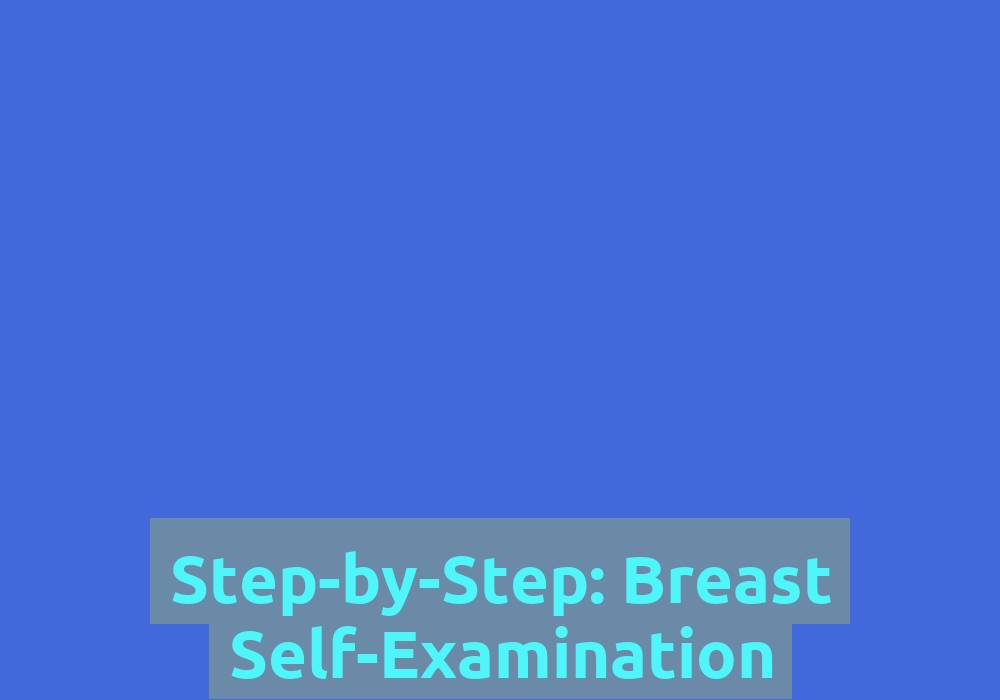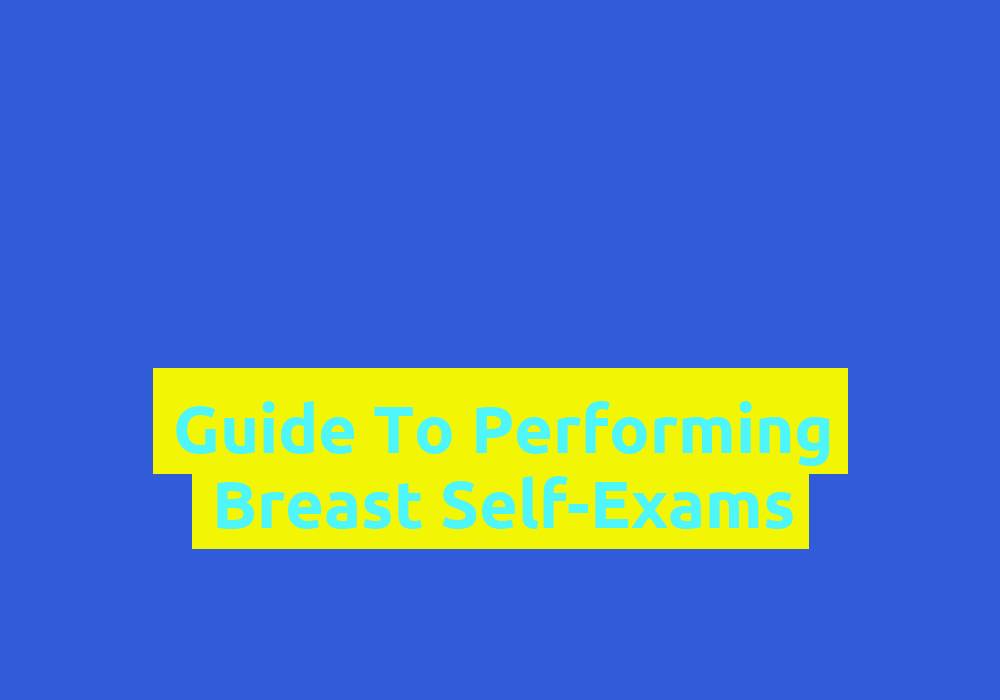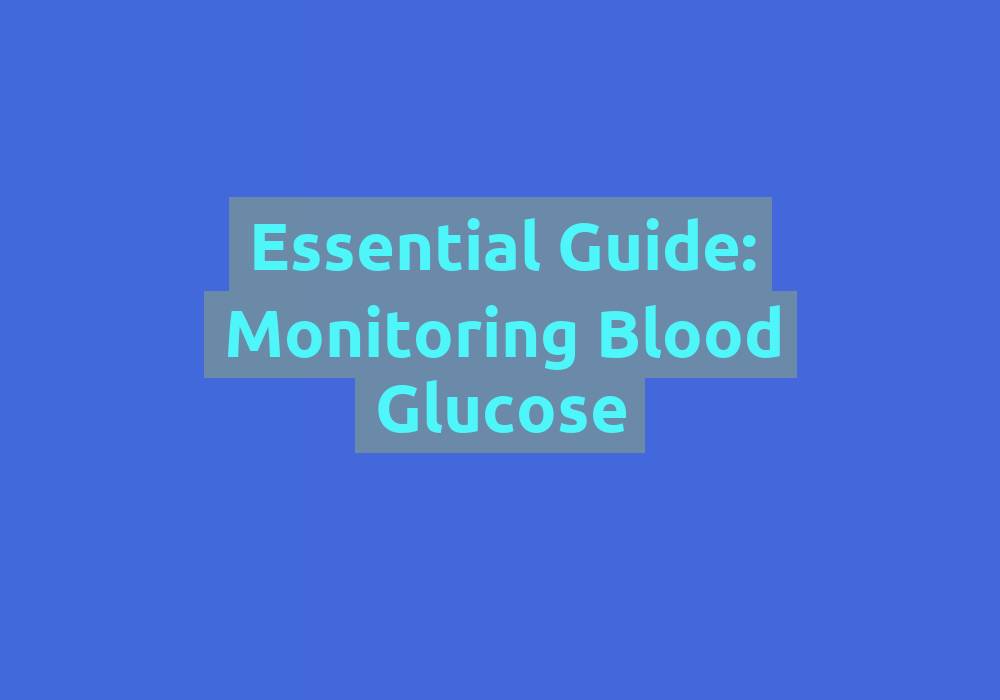Step-by-Step: Breast Self-Examination

Breast self-examination (BSE) is a crucial practice that every woman should incorporate into her regular healthcare routine. It is a simple yet effective way to detect any abnormalities or changes in the breasts, potentially enabling early detection of breast cancer. By following a step-by-step approach, you can perform a thorough self-examination at home, increasing your awareness and promoting breast health.
Why is Breast Self-Examination Important?
Breast cancer is one of the most prevalent forms of cancer affecting women worldwide. Early detection plays a vital role in improving treatment outcomes and survival rates. By performing regular breast self-examinations, you become familiar with your breasts’ normal appearance, texture, and feel. This knowledge empowers you to identify any changes or irregularities promptly. Remember, the sooner you detect a potential problem, the better your chances of seeking medical attention and receiving timely treatment.
Breast self-examination is also an opportunity to take control of your own health and well-being. By actively participating in your breast health, you can feel empowered and proactive in managing any potential risks. It allows you to establish a baseline for your breasts’ normal characteristics, making it easier to notice any deviations from the norm. Additionally, regular self-examinations promote breast awareness and help you develop a closer relationship with your body, fostering a sense of self-care and self-advocacy.
Step 1: Preparation
Before starting a breast self-examination, it is essential to create a comfortable and distraction-free environment. Follow these steps to prepare for the examination:
- Find a quiet and well-lit room where you can comfortably stand in front of a mirror. Adequate lighting is crucial as it helps you observe any changes or abnormalities more effectively.
- Remove your clothing from the waist up and undress from the waist down, keeping your upper body exposed. This allows for unrestricted movement and access to your breasts.
- Stand upright with your arms relaxed at your sides. This posture helps you maintain a neutral position and facilitates a more accurate visual examination.
Creating a calm and focused atmosphere during the preparation stage is essential for ensuring a thorough and accurate self-examination. Remember to choose a time when you are unlikely to be interrupted, allowing yourself the necessary privacy and concentration.
Step 2: Visual Examination
The visual examination allows you to observe your breasts for any visible changes or abnormalities. Follow these guidelines to conduct a thorough visual examination:
- Start by facing the mirror and examining your breasts for any changes in size, shape, or symmetry. Look for any obvious differences between your breasts, such as swelling, distortion, or changes in contour.
- Observe for any dimpling, puckering, or changes in skin texture, such as redness or a rash-like appearance. These changes can indicate underlying issues that require medical attention.
- Raise your arms above your head and assess the same characteristics as mentioned above. Pay attention to any changes in your breasts’ appearance or the movement of the breasts when your arms are raised.
- Place your hands on your hips and flex your chest muscles, looking for any irregularities in movement or contour. This maneuver helps highlight any subtle changes that may not be apparent in the relaxed position.
- Finally, examine your nipples for any discharge, inversion, or scaliness. Check for any changes in the nipple’s shape, color, or texture, as these can be potential signs of concern.
During the visual examination, it is crucial to be thorough and observant. Take your time to carefully inspect each breast from different angles, ensuring that you don’t miss any potential abnormalities. If you notice any differences or changes, make a note of them for future reference.
Step 3: Manual Examination
The manual examination allows you to feel for any lumps, nodules, or other abnormalities within your breasts. Follow the steps below to perform a thorough manual examination:
- Lie down on a comfortable surface, such as a bed or a yoga mat. This position helps you relax and provides better access to your breasts.
- Place a small pillow or towel under your right shoulder and raise your right arm behind your head. This position helps flatten the breast tissue and makes it easier to examine.
- Using your left hand, feel your right breast in a circular motion, starting from the outer edge and gradually moving toward the nipple. Take note of any areas that feel different, such as lumps, thickening, or areas of tenderness.
- Apply light pressure for the first round, gently palpating the entire breast to familiarize yourself with its texture and normal variations.
- Increase the pressure to a medium level for the second round, focusing on detecting any deeper abnormalities that may not be easily noticeable.
- In the final round, apply firm pressure to detect any prominent lumps or nodules that may require medical attention.
- Divide your breast into quadrants and ensure to cover the entire surface, including the armpit area (axillary region). This ensures a systematic and thorough examination.
- Repeat the same steps for your left breast, using your right hand while raising your left arm. Remember to vary the pressure applied during each round to ensure a comprehensive examination.
By performing a manual examination, you can detect any abnormalities that may not be visible to the naked eye. It is important to be gentle yet thorough, paying attention to any changes in texture, size, or consistency. Remember that breast tissue can feel lumpy or have natural variations, but any new or unusual changes should be brought to the attention of your healthcare provider.
Step 4: Repeat Regularly
Performing a breast self-examination should be a regular part of your healthcare routine. To ensure optimal breast health, follow these recommendations:
- Perform a self-examination once a month, preferably a few days after your menstrual cycle ends. Hormonal changes during the menstrual cycle can affect the breast tissue, so conducting the examination when your breasts are less tender and swollen is ideal.
- If you have reached menopause or no longer have a regular cycle, choose a specific day each month to perform the examination consistently. This helps establish a routine and ensures that you don’t skip any examinations.
- Keep track of any changes or abnormalities you notice during self-examinations and report them to your healthcare provider promptly. Maintaining a record of your findings helps you identify patterns and provides essential information for your healthcare professional.
Consistency is key when it comes to self-examinations. By performing regular checks, you become more attuned to your breasts’ normal variations, making it easier to identify any changes that may require further investigation. Additionally, by promptly reporting any concerns to your healthcare provider, you can ensure timely evaluation and appropriate management if needed.
Final Thoughts
Breast self-examination is a proactive and empowering approach to maintaining your breast health. By familiarizing yourself with the normal appearance and feel of your breasts, you can quickly detect any changes that may require medical attention. Remember, self-examinations are not a substitute for professional screenings, such as mammograms, but they serve as an essential complement to regular check-ups. Stay proactive, stay vigilant, and make breast self-examination a priority in your life. Regular self-examinations, in combination with other preventive measures and screenings, contribute to a comprehensive breast health strategy that can lead to early detection and improved outcomes. Take charge of your breast health today.
Breast self-examination is important because it allows you to become familiar with the normal appearance, texture, and feel of your breasts. By regularly examining your breasts, you can identify any changes or abnormalities early on, potentially leading to early detection of breast cancer and improved treatment outcomes.
- How should I prepare for a breast self-examination?
To prepare for a breast self-examination, find a quiet and well-lit room where you can comfortably stand in front of a mirror. Remove your clothing from the waist up and undress from the waist down, keeping your upper body exposed. Stand upright with your arms relaxed at your sides to maintain a neutral position for a visual examination.
- What should I look for during the visual examination?
During the visual examination, you should look for changes in size, shape, or symmetry of your breasts. Observe for dimpling, puckering, changes in skin texture, redness, or a rash-like appearance. Raise your arms above your head and assess the same characteristics. Also, place your hands on your hips and flex your chest muscles to look for any irregularities in movement or contour. Examine your nipples for discharge, inversion, scaliness, changes in shape, color, or texture.
- How do I perform a manual breast examination?
To perform a manual breast examination, lie down on a comfortable surface with a small pillow or towel under your shoulder. Raise your arm behind your head to flatten the breast tissue. Using the opposite hand, feel your breast in a circular motion, starting from the outer edge and moving toward the nipple. Apply light, medium, and firm pressure in different rounds to detect any abnormalities. Divide your breast into quadrants and cover the entire surface, including the armpit area. Repeat the same steps for the other breast.
Note: The FAQ responses were generated based on the content of the provided blog article and may not cover all aspects or variations of breast self-examination. It is always recommended to consult healthcare professionals for personalized advice and guidance.


















